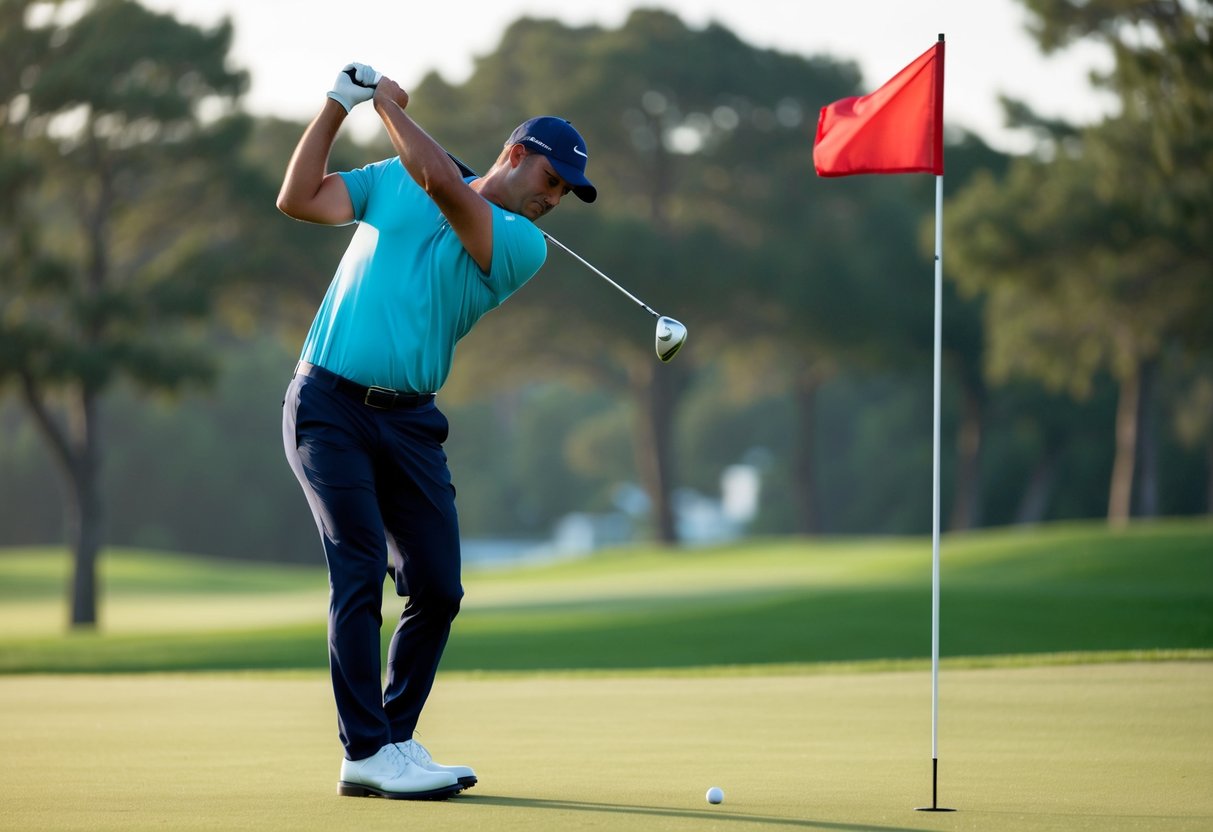Check out our golf rangefinders by Vovex to elevate your game!
Playing golf in the wind presents unique challenges that can frustrate even the most experienced players. Wind affects everything from ball flight to club selection, often turning a routine round into a strategic battle against the elements. Adapting your game to windy conditions requires specific adjustments to both technique and strategy, including choking down on the club, taking less backswing, and selecting clubs based on wind direction rather than distance alone.
We've all watched professional golfers masterfully navigate blustery conditions, seemingly unfazed as they shape shots through challenging crosswinds. The good news is that with proper understanding and practice, recreational golfers can develop similar skills. Wind doesn't have to ruin your round—it can actually make you a more creative and versatile player when you know how to work with it rather than fight against it.
Key Takeaways
- Adjust your club selection by adding clubs for headwinds and reducing clubs for tailwinds while maintaining a smoother, controlled swing.
- Keep your ball flight lower in windy conditions by positioning the ball back in your stance and limiting your follow-through.
- Embrace a strong mental game by accepting wind challenges, making conservative target selections, and focusing on solid contact rather than distance.
Understanding Wind Dynamics on the Golf Course
Wind is perhaps the most influential natural element on your golf game, affecting everything from ball flight to club selection. Mastering wind dynamics can transform your performance on windy days from frustrating to advantageous.
The Basics of Wind Effects on Ball Flight
Wind influences your golf ball in predictable but powerful ways. Headwinds decrease distance and increase ball height, typically requiring 1-2 club adjustments. When facing a 15 mph headwind, expect to lose approximately 15-20 yards on a mid-iron shot.
Tailwinds do the opposite, extending distance while flattening trajectory. Many golfers make the mistake of not adjusting enough with tailwinds. A 15 mph tailwind might add 10-15% to your normal distance.
Crosswinds create the most complex challenges. A right-to-left crosswind (for right-handed players) will exaggerate a draw and fight against a fade. The rule of thumb we follow:
- Light wind (5-10 mph): Minimal adjustment needed
- Moderate wind (10-20 mph): Aim 5-15 yards into the wind
- Strong wind (20+ mph): Consider playing a lower trajectory shot
Reading the Wind: Tips for Accurate Perception
Wind assessment begins before you ever reach for a club. Watch flagsticks, trees, and grass movements for clues about direction and intensity. Don't just check at ground level - winds at ball height often differ significantly.
The best wind readers use multiple indicators. Throw grass in the air, but also look for distant signs like smoke from chimneys or ripples on water hazards. These provide information about wind patterns across the entire hole.
Wind consistency matters tremendously. Is it gusting or steady? Gusting winds require more conservative play, while steady winds allow for more predictable adjustments.
Elevation changes complicate wind reading. Wind typically intensifies at higher elevations and in open areas of the course. When playing elevated tees, we recommend checking wind conditions both at the tee box and near the landing area.
Adjusting Your Swing in Windy Conditions
Wind challenges even the most skilled golfers, demanding strategic adjustments to your swing technique. Proper modifications to your setup and swing mechanics can help maintain control and accuracy when the breeze picks up.
The Knockdown Shot: Technique and Execution
The knockdown shot is your best friend in windy conditions. To execute it properly, position the ball slightly back in your stance and place more weight on your lead foot. This setup promotes a steeper angle of attack.
Take a shorter backswing than normal—about 75% of your full swing. Your hands should lead the clubhead through impact, keeping the ball flight lower.
Swing with deliberate tempo and choose a stronger club than usual. For example, if you'd normally hit an 8-iron, select a 7-iron or even a 6-iron instead.
The goal isn't maximum distance but rather control and predictability. Practice feeling like your follow-through is abbreviated, with your hands finishing lower than in your standard swing.
Maintaining Balance and Stability
Strong winds can easily disrupt your balance during the swing. Widen your stance slightly beyond your normal width to create a more stable base. This simple adjustment immediately improves your stability.
Grip pressure matters tremendously in windy conditions. Maintain a slightly firmer—but not tight—grip to prevent the club from twisting in your hands during the swing.
Focus on a smooth tempo rather than swinging harder. Many golfers instinctively swing harder against the wind, which typically worsens accuracy issues.
Keep your lower body quiet throughout the swing. Excessive leg movement can throw off your balance when battling gusts. Think about turning around your center rather than shifting weight dramatically.
Club Selection Strategies
Proper club selection is essential when battling the wind on the golf course. The right club choice can mean the difference between landing safely on the green and watching your ball sail into trouble.
Choosing the Right Club for Headwinds and Tailwinds
When facing a headwind, we recommend taking 1-2 clubs more than you normally would for that distance. A shot that typically requires a 7-iron might need a 5-iron in strong headwinds. Remember the golfer's adage: "When it's breezy, swing easy." A smoother, more controlled swing often produces better results than trying to overpower the wind.
In tailwinds, do the opposite—choose 1-2 clubs less than normal. A tailwind can add 10-30 yards to your shot depending on its strength. Be careful not to overswing, as tailwinds can exaggerate any spin you put on the ball.
Wind Strength Guide for Club Selection:
- Light wind (5-10 mph): Add/subtract half a club
- Moderate wind (10-20 mph): Add/subtract one full club
- Strong wind (20+ mph): Add/subtract two or more clubs
Assessing Impact of Crosswinds on Club Choice
Crosswinds require a different approach to club selection. We need to consider both distance and direction when choosing our club. For a right-to-left crosswind (for right-handed players), select a club with less loft to minimize the wind's effect on the ball's flight path.
For left-to-right crosswinds, consider using a club with slightly more loft. This helps counteract the wind's tendency to accentuate a slice. Generally, keeping the ball lower helps reduce the wind's influence.
Try this technique: For crosswinds, choose your normal club but adjust your aim. A good rule of thumb is to aim 5-10 yards into the wind for every 10 mph of crosswind speed. This allows the wind to bring your ball back toward the target.
Pro tip: Practice shots with different clubs in crosswinds to develop a feel for how your ball typically reacts to various wind conditions with each club in your bag.
Alterations in Shot Making
Wind fundamentally changes the way we execute golf shots, requiring thoughtful adjustments to both technique and club selection. Successful players recognize that wind demands more than just "hitting it harder" or "swinging easier" - it requires strategic alterations to shot shape and trajectory.
Navigating Upwind and Downwind Shots
When playing into the wind, we need to minimize flight time by choosing more club and swinging with about 75-80% of normal power. This creates a more penetrating ball flight that cuts through the resistance.
A simple rule of thumb: add one club for every 10 mph of headwind. For example, a standard 7-iron shot might require a 6-iron or even 5-iron in a 20 mph headwind.
Downwind shots behave oppositely - the ball will travel further and land with less spin. We recommend:
- Reducing club selection (often 1-2 clubs less)
- Setting up with the ball slightly back in your stance
- Focusing on clean contact rather than extra power
Remember that downwind shots typically run more after landing, so account for this additional roll when planning your approach.
Managing Side Winds: Fade or Draw?
Side winds present a different challenge, requiring us to work with (or against) the wind's natural effect on ball flight. The traditional advice of "playing into the wind" often serves us well.
When facing a right-to-left wind, utilize it by:
- Setting up for a draw shot (closed stance, inside-out swing path)
- Aiming further right than normal
- Allowing the wind to help bring the ball back to target
For left-to-right winds, a fade technique works best. We should:
- Open our stance slightly
- Align clubface to target
- Make a slightly out-to-in swing path
Pro tip: In extremely strong crosswinds, sometimes it's better to hit a lower, "boring" shot that minimizes the wind's effect altogether, sacrificing distance for accuracy and control.
On-Course Adjustments for Windy Play
Wind demands quick thinking and flexibility on the golf course. The ability to adapt your game plan and make real-time adjustments separates experienced players from beginners when the gusts pick up.
Strategic Course Management
When playing in windy conditions, we need to reconsider our typical course strategy. Aim for wider landing areas to accommodate potential wind drift, even if it means taking a slightly longer approach shot.
Playing to the center of greens becomes much more valuable than hunting pins, especially when they're positioned near hazards. Consider playing one or even two clubs less off the tee to keep the ball lower and more controlled.
Look for natural windbreaks like trees or hills that might offer protection on certain holes. Remember the "Wind in your face, take more space" rule - meaning you'll need significantly more club when hitting into the wind.
Water hazards become particularly dangerous in crosswinds, so give them extra clearance. Don't be afraid to lay up more often when the wind makes reaching targets risky.
Adapting Putting Technique in Wind
Strong winds affect putting more than most golfers realize. On exposed greens, a 20 mph crosswind can push your ball several inches off line over a 10-foot putt.
Key adjustments for wind putting:
- Widen your stance slightly for better stability
- Grip down on the putter for more control
- Use a firmer stroke to limit wind influence
- Play less break when putting downwind
- Expect more break when putting into the wind
We've found that putting with the flagstick in during windy conditions can be advantageous. The flag provides a visual indicator of wind strength and direction at green level.
Try practice strokes beside (not behind) your ball to feel how the wind might affect your putting motion. Above all, commit fully to your adjusted read - hesitation magnifies wind effects.
Mental Game and Wind Challenges
Playing in windy conditions demands not just physical adjustments but significant mental fortitude. The psychological aspects of wind management can often make the difference between shooting a decent score and letting the conditions ruin your round.
Maintaining Focus Amidst Distractions
Wind creates multiple distractions that can derail your concentration. The sound of flapping flags, swaying trees, and gusting sand can pull your attention away from the shot at hand. We recommend establishing a consistent pre-shot routine that anchors your focus regardless of conditions.
Take a deep breath before addressing the ball, and mentally commit to your adjusted plan. Trust your wind calculations once you've made them—second-guessing only increases tension.
Many pros visualize the shot's entire flight path, including how the wind will move it. This mental rehearsal builds confidence.
Remember to reset after each shot. Wind conditions may have cost you a stroke on the last hole, but carrying that frustration forward only compounds the problem.
Coping with Frustration and Making Decisive Choices
Windy days inevitably bring unexpected outcomes. Even perfect swings can lead to disappointing results when a gust catches your ball. We've found that setting realistic expectations before the round helps manage frustration.
Accept that you'll likely score a few strokes higher than normal. This mental adjustment prevents disappointment from spiraling into poor decision-making.
When faced with challenging wind conditions, decisive commitment becomes crucial. Hesitation typically leads to poor execution. Make your club selection, commit to your target, and execute without doubt.
Consider keeping a "wind journal" to document how different wind conditions affected your shots. This builds experience you can draw upon in future rounds.
Remember that everyone in the field faces the same challenges—those who embrace rather than fight the wind usually fare best.
Practice Drills for Windy Conditions
Mastering golf in windy conditions requires specific practice routines that simulate real-world challenges. The right drills can help you develop the feel and technique needed when facing different wind directions and speeds on the course.
Targeted Drills to Improve Wind Play
Start with the "Three-Height Challenge" by practicing low, medium, and high shots with each club. Hit 5 balls at each height, focusing on controlling trajectory rather than distance. This builds versatility when wind conditions change mid-round.
Set up the "Clock Drill" by placing targets at 12, 3, 6, and 9 o'clock positions around you. Practice hitting to each target while imagining different wind directions, adjusting your stance and swing path accordingly.
Try the "Half-Club Challenge" where you deliberately use one club less or more than normal. Swing at 75-80% power to develop control. This teaches you to adapt when wind affects your standard distances.
We recommend the "Punch Shot Series" for headwinds. Position the ball back in your stance, use a shorter backswing, and focus on a low follow-through. Practice with different clubs to master this essential wind shot.
Simulating Windy Conditions for Effective Training
Use a portable fan during practice sessions if you don't have naturally windy days. Position it to create crosswinds, headwinds, and tailwinds while you practice your normal routine.
Create "Artificial Pressure" by setting challenging targets that require wind-adjusted shots. For example, place five small targets at various distances and try to hit at least three in ten attempts.
Practice your "Wind Assessment Routine" by taking five extra seconds before each practice shot to feel the wind, check nearby flags or trees, and verbalize your adjustment plan. This builds the habit for actual play.
Incorporate the "9-Shot Drill" where you intentionally hit draws, fades, and straight shots at three different heights. This comprehensive practice ensures you're prepared for any combination of wind conditions.
Equipment Considerations in the Wind
Wind can dramatically affect your golf game, but having the right equipment and knowing how to adjust it can give you a significant advantage on blustery days. Your equipment choices become even more critical when facing challenging wind conditions.
Selecting the Right Golf Ball
In windy conditions, the golf ball you choose makes a tremendous difference. Low-spin balls are your best friends when playing in the wind. They reduce the lift that can send your ball off course in crosswinds.
We recommend using balls with firmer covers and lower compression ratings when it's windy. Brands like Titleist Pro V1x, Callaway Chrome Soft X, or TaylorMade TP5x offer excellent wind performance characteristics.
Consider these ball characteristics for windy rounds:
- Lower spin rate: Helps maintain straighter flight
- Firmer feel: Reduces lift in crosswinds
- Heavier ball: Cuts through wind more effectively
Don't bring your high-spin, soft-feel balls to a windy course. They'll balloon in the air and lose significant distance when playing into headwinds.
Adjusting Equipment Settings for Wind
Modern clubs offer numerous adjustability options that can help you manage windy conditions. When facing consistent wind, we suggest adjusting your driver settings to promote a lower ball flight.
Driver adjustments:
- Lower the loft by 1-2 degrees
- Move weight settings forward to reduce spin
- Consider using a shorter tee height
Your iron setup can also be modified for windy play. Try choking down slightly on the grip and selecting one club longer than usual when playing into the wind. This promotes a more penetrating ball flight.
Consider carrying additional specialty clubs on windy days, such as a driving iron or utility club. These low-lofted options help keep the ball under the wind and provide more control when accuracy is at a premium.
Clothing and Accessories for Comfort and Performance
Playing golf in windy conditions requires thoughtful clothing choices to maintain comfort and performance. We've found that layering is essential for adapting to changing temperatures that often accompany windy days.
A moisture-wicking base layer helps manage perspiration while providing insulation. Over this, we recommend a lightweight mid-layer that offers warmth without restricting your swing.
Wind-resistant outerwear is perhaps the most crucial element. Look for jackets specifically designed for golf that feature:
- Stretch panels at shoulders and arms
- Shorter cut in front to avoid interference during putting
- Adjustable cuffs to prevent flapping
- Windproof but breathable materials
Hats and caps deserve special attention in windy conditions. Opt for secure-fitting headwear with adequate brims to shield your eyes from sun while not catching too much wind.
Gloves become even more important when playing in wind. Consider keeping an extra pair dry in your bag, as wind can accelerate moisture evaporation and cause your grip to deteriorate.
Eyewear protection is often overlooked but crucial. Wind causes eyes to water, affecting vision and concentration. We suggest wraparound sunglasses that block both UV rays and wind.
For footwear, shoes with excellent traction provide stability during your swing when gusts try to throw you off balance. Models with waterproof features are beneficial as windy days often follow or precede rain.
Frequently Asked Questions
Wind presents unique challenges on the golf course that require smart adjustments to your strategy and club selection. Many golfers struggle with calculating distance changes and selecting the right shot type when facing strong gusts.
What are the best ways to adjust yardages for 20 to 40 mph wind conditions on the golf course?
For winds between 20-40 mph, we recommend more significant club adjustments than you might typically make. In a 20 mph headwind, add two clubs to your normal selection. As wind speeds approach 40 mph, consider adding three to four clubs.
Remember that wind direction matters tremendously. A 30 mph headwind might require three extra clubs, while the same wind as a tailwind could mean subtracting two to three clubs from your normal selection.
Practice shots with varying wind strengths during training sessions will help develop your feel for these adjustments. Track your results to build a personal reference guide for future rounds.
Can you provide a rule of thumb for calculating how wind affects golf shot distances?
A common rule is the "10% rule" - for every 10 mph of direct headwind, expect approximately 10% less distance on your shot. Conversely, a 10 mph tailwind generally adds about 10% to your carry distance.
For crosswinds, the impact is more complex but typically less severe. A 10 mph crosswind might affect your distance by 3-5% while significantly altering your ball's lateral movement.
High shots are affected more dramatically than low trajectory shots. A high flying wedge shot may lose 15-20% of its distance in a 10 mph headwind.
Which type of golf ball performs best in high wind conditions and why?
Lower compression golf balls with fewer dimples tend to perform better in windy conditions. These balls typically produce less spin and lower ball flight, helping maintain control against strong gusts.
Many tour players switch to these types of balls when facing windy tournament conditions. Brands like Titleist Pro V1x, Bridgestone Tour B X, and TaylorMade TP5x offer models designed to minimize wind effects.
The dimple pattern is crucial - balls with shallower, more numerous dimples create less drag and maintain better stability in crosswinds. However, this may come at the cost of some spin control around greens.
How can I use a golf wind calculator to improve my game strategy on blustery days?
Wind calculators available on smartphone apps like GolfLogix, SwingU, and 18Birdies provide real-time wind assessments based on your location. These tools analyze wind speed, direction, and how they interact with your typical shot patterns.
We suggest using these calculators during practice rounds to build a personal reference guide. Input your normal carrying distances, then note how different wind conditions affect your actual results.
Most advanced wind calculators factor in elevation changes and temperature, which also impact ball flight. These additional variables can make a significant difference in your club selection and strategy.
What are the most effective techniques for swinging the golf club in heavy crosswinds?
In strong crosswinds, grip pressure becomes critical. We recommend slightly firmer grip pressure than normal to maintain control through impact.
Widen your stance slightly to create a more stable base. This helps prevent unwanted body movement that can exaggerate wind effects on your shot.
Swing at about 80% of your maximum power. This controlled swing promotes better contact and reduces excessive spin that can cause the wind to dramatically alter your ball flight.
Could you explain how wind speed impacts golf ball trajectory and how to compensate for it?
Wind creates lift and drag forces that directly affect trajectory. Headwinds increase drag and reduce distance while creating more lift that makes the ball climb higher—exactly what you don't want in windy conditions.
To compensate, we recommend positioning the ball slightly further back in your stance. This promotes a lower ball flight that penetrates through the wind rather than ballooning against it.
Club selection becomes critical in managing trajectory. Consider using more club with an easier swing rather than less club with a harder swing. This combination naturally produces a lower, more controlled flight path ideal for windy conditions.






